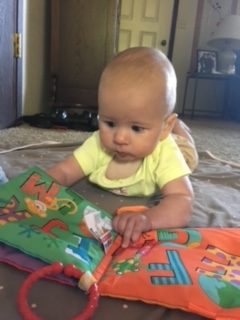“Normal” Developmental Milestones for Your Child Part 2: Spinal Curvatures

“Children are not things to be molded, but people to be unfolded.” – Jess Lair
There are tons of developmental milestones, but I want to focus on what I know best: the spine. The lordosis curves (secondary curves) of the spinal column are developed via major milestones: lifting the head and sitting/standing/walking. Without letting these things happen naturally at the baby’s own pace, there can be long-term effects on the baby’s neurology.
In the womb the baby’s spine is in a C-shape, which is perfect for the cramped space (moms, I know you know what I mean when I say cramped) but it is necessary for our spines to form lordosis curves as we age to protect our spines and spinal cords from injury. The S-shape curve of an adult allows optimal structural support.
The first lordosis curve of the spine to develop is the cervical curve (neck). This curve is formed as the baby begins to lift her head. This milestone not only provides the shaping of the cervical curve and training of the postural muscles, but also aids in enhancing visual awareness. This enhanced visual perspective contributes to additional milestones such as reaching, grasping and spatial awareness. It is important the give the baby plenty of tummy time so she can practice pushing herself up to observe the world around her.
The second lordosis curve is the lumbar curve (low back). The curve is not fully developed for several years but begins as the baby starts to sit, stand and walk. The development of this curve is essential to upright posture. If not formed properly a child/adult can suffer from low back pain, postural aches, and much more (remember your spinal column house your very important spinal cord with nerves exiting the spinal column that control functions in your body like moving, feeling pain, digesting food, etc etc get my point?) It is very important to NOT put your child in a supported seated position before they can sit by themselves; you are robbing them of their own neurological development. The same goes for standing and walking.
This a beautiful and amazing world we live in, take time to enjoy revisiting each wonder it holds with your child as they begin to explore it for the first time. And of course, remember to get you baby check by a chiropractor through each of these milestones to make sure all those bumps and falls aren’t accumulating to be harmful to the developing neurology.
Added bonus: Haven’t been won over yet? Check this out- crawling is one of the most important things we do to develop brain-body connection and control. Cross crawl promotes the communication of the right and left hemispheres, which will aid in future activates that require “both” sides of your brain: walking, talking, dancing, listening/studying, and so much more.
Try this at home (warning: if performed in front of friends/family you might be laughed at, pay no mind and do it anyways): lay on your back and try moving opposite arm/leg in a walking/crawling movement, alternating between sides just as you would walking. Does this feel in the slightest bit awkward? If you don’t think about it, do you slip into a same side leg/arm pattern? Can you do it while talking or thinking about something else? If your answer is “no” to any of these, guess where I’m going to suggest you go? That’s right, a chiropractor. This type of holistic doctor will recognize this as a possible disconnect between right-left hemisphere and/or hemisphere-body dysfunction. A chiropractor will utilize special training to help restore proper neurological function in these cases.
Hope and Health,
Dr. Madison
Photo Credit: Jupiterimages/Comstock/Getty Images
About The Author
Dr Madison
Related Posts
Normalize Bed-Sharing
Our second daughter was born at home. From her very first night until she decided…
March 24, 2021TOP THREE SUPPLEMENTS FOR KIDS- When, Which Ones, and Why
Should you be giving your young children supplements? This is a question that often comes…
October 7, 2020
